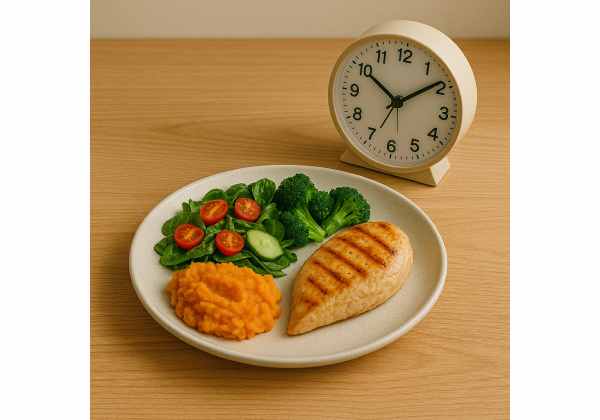
Appetite is not random. It follows a rhythm shaped by sleep, light, stress, and the timing and composition of your meals. When meals drift late or bunch together, hunger swings and cravings rise. When timing is steady, protein and fiber show up on schedule, and evenings wind down predictably, appetite becomes easier to manage—even on busy days. This guide turns meal timing into simple actions you can repeat without calorie math. For a broader foundation that includes sleep and stress routines, start with our practical habits-first framework, then use the playbook below to tune your timing for calm, reliable hunger.
Table of Contents
- Meal timing and appetite
- When to eat each day
- Protein and fiber by meal
- Fix the 4 p.m. crash
- Evening hunger and late meals
- Workouts, shifts and fasting
- Track, review and adjust
- Frequently Asked Questions
Meal timing and appetite
Your appetite system relies on cues. Some you can control—when you eat, what is on the plate, how bright your evening is—and some you can only influence—work schedules, family logistics, travel. The goal is not precision; it is predictability. Predictable timing reduces the highs and lows that lead to grazing.
How timing shapes hunger
- Ghrelin rises before expected mealtimes. If breakfast slides around each day, ghrelin gets louder at odd hours. A steady first meal trains a steadier signal.
- Leptin and gut fullness hormones respond to protein and fiber. Regular meals with both create longer satisfaction and fewer “emergency snacks.”
- Circadian rhythm sets daily patterns for digestion and insulin sensitivity. Large late-night meals can disturb sleep, which increases next-day cravings.
What “good timing” looks like
- Three anchor meals spaced roughly 3–5 hours apart for most people.
- Protein at each meal (about 25–35 g) and fiber (fruit, vegetables, beans, whole grains).
- A reliable evening wind-down (tea, teeth, dim lights) to close the kitchen and protect sleep.
- Post-meal movement, even brief, to mark a clear end to eating and smooth energy.
Why this matters for weight change
Stable timing reduces overeating without willpower. You show up to dinner steady instead of ravenous. You stop picking through the night because a kitchen-close ritual compresses the eating window. You do not need strict rules—just a handful of rhythms that repeat on weekdays, weekends, and travel.
Expectations and flexibility
- You do not need to eat by the clock. Tie meals to consistent events—after school drop-off, after the 1 p.m. meeting, after the commute.
- If a day goes off-script, return to anchors at the next opportunity. A single normal plate resets faster than skipping and “making up for it” later.
- Start with the first meal and last hour of the day. When those two bookends are steady, the middle becomes easier to adjust.
If you are new to healthy weight change or want context for safe pace, plate design, and routines, glance at our concise foundational guide and then return here. The sections below map timing into concrete steps you can use today.
When to eat each day
Design a day you can repeat. The times are less important than the sequence and spacing. Use the template below and adjust to your wake time and work blocks.
A practical daily template (example times assume 7:00 a.m. wake)
- 7:30–8:30 a.m. — First meal (M1): Protein-forward breakfast with fruit or vegetables. Hydrate with 300–500 ml water or tea. A steady M1 stabilizes mid-morning hunger.
- 12:00–1:30 p.m. — Second meal (M2): Balanced plate. Add a short 5–10 minute walk afterward to reduce afternoon sluggishness.
- 3:30–4:30 p.m. — Optional snack (S): Only if truly hungry or dinner will be late. Choose protein + fiber (cottage cheese and tomatoes; Greek yogurt and berries; apple with 1 tbsp peanut butter).
- 6:30–8:00 p.m. — Third meal (M3): Protein + vegetables + a smart starch. A 10-minute walk after dinner improves digestion and marks “eating is done.”
- 9:00–10:00 p.m. — Wind-down: Tea, teeth, lights down. Dimmer light narrows the snack window.
Spacing rules you can remember
- Aim for 3–5 hours between M1, M2, and M3. If a gap will be longer, plan a small snack; if meals are close, skip it.
- Do not “bank calories” by skipping all day. People rarely win that trade—hunger rebounds and evening intake overshoots.
- If mornings are hectic, pre-decide M1 the night before. Even a portable option counts.
Travel and busy days
- Tie meals to events instead of clock time. For example: M1 after airport security, M2 mid-flight or at your first stop, M3 on arrival.
- Carry one shelf-stable protein (jerky, tuna pouch, roasted chickpeas) and one fruit. These bridge long gaps without vending machine detours.
Small habits that amplify timing
- Put water on your nightstand and drink on waking.
- Prepare breakfast components while dinner cooks (oats measured, yogurt portioned, fruit washed).
- Keep a default “late dinner”—scrambled eggs and vegetables, beans and rice with salsa, or a high-protein pasta and tomato sauce—so you are never negotiating with takeout at 9 p.m.
Post-meal movement is a quiet lever that helps timing work better. For a simple approach you can apply after lunch or dinner, see our quick guide to 10-minute walks and copy the version that fits your neighborhood, office, or hallway.
Protein and fiber by meal
Timing sets the rhythm; protein and fiber set the stability. When each meal hits minimums for both, hunger signals calm and the next meal arrives without urgency.
Targets that work without calorie counting
- Protein: 25–35 g per main meal. Think a palm to palm-and-a-half of lean meat or tofu, ¾–1 cup cottage cheese, 1½ cups Greek yogurt, or a bean-and-grain combo.
- Fiber: Build toward 25–38 g/day from fruit, vegetables, beans, and whole grains. In practice: 1–2 cups produce per meal plus beans or whole grains most days.
Meal-by-meal examples
- Breakfast (M1):
- Greek yogurt (1½ cups) + oats (¼–½ cup) + berries
- Eggs (2–3) + sautéed vegetables + fruit
- Tofu scramble (150–200 g) + vegetables + a slice of whole-grain toast
- Lunch (M2):
- Big salad (2 cups vegetables) + chicken, tuna, tofu, or beans + whole-grain roll
- Grain bowl: brown rice or quinoa (½–1 cup), beans or lentils (¾ cup), roasted vegetables, vinaigrette
- Dinner (M3):
- Sheet-pan fish or chicken + two roasted vegetables + potatoes or rice
- Stir-fry tofu/tempeh + mixed vegetables + rice or noodles
- Chili with beans + side salad
Snack structure (only when needed)
- Pair protein + fiber: cottage cheese and tomatoes; yogurt and berries; apple with 1 tbsp peanut butter; hummus on rice cakes with turkey.
- Keep snacks measured and seated. One bowl, one spoon, one seat. Standing at the counter blurs portion memory.
Plating cues that keep you out of the weeds
- Start with vegetables first. Filling half the plate automatically raises fiber.
- Add a palm of protein next.
- Finish with a cupped hand of starch (½–1 cup), adjusted to your activity level.
What about beverages and add-ons?
- Include a thumb of added fat (olive oil, nuts, seeds, avocado) for satisfaction.
- Hydrate at each meal; mild dehydration feels like “snacky.”
Prefer to work without numbers altogether? Our straightforward plate method and protein targets show you how to set portions visually while keeping timing steady. The combination—predictable meal times plus reliable plate structure—solves most day-to-day appetite swings.
Fix the 4 p.m. crash
Afternoons are where good intentions stall. You eat lunch at your desk, meetings run long, and suddenly the workday ends with a raid on the pantry. Solve the crash with earlier decisions, not later willpower.
Root causes
- Low-protein lunch that burns off quickly
- Long gaps (5–6+ hours) between meals
- Caffeine timing too late or too little hydration
- Decision fatigue after stacked tasks
Countermeasures
- Upgrade M2 protein and fiber. Add an extra palm of protein or a cup of beans, and at least two cups of vegetables or a piece of fruit.
- Pre-decide a 3:30 p.m. option if dinner will be late: Greek yogurt with berries; cottage cheese with tomatoes; tuna on rice cakes. Set a calendar nudge.
- Move briefly. Do a 5–10 minute walk after lunch or take two flights of stairs. Movement blunts the dip and breaks the snack autopilot.
- Hydrate earlier. Drink 300–500 ml water by mid-afternoon. Thirst often masquerades as hunger at day’s end.
- Tidy the decision path. Put a single-serve snack at eye level, not a family-size bag on the counter. Plate it, sit, and eat—then close the container.
If the crash hits anyway
- Eat a planned snack slowly and seated. Then brush your teeth or drink tea to create a pause before dinner.
- Avoid grazing through cooking. Chewing gum or sipping seltzer helps some people during meal prep.
For fast snack ideas built specifically to tame cravings, keep a few options from our practical craving toolkit on hand. A single protein + fiber choice at 4 p.m. beats an unplanned whirlwind at 6:30 p.m.
Evening hunger and late meals
Evenings stretch willpower thin. Tired brains prefer quick energy, bright rooms keep you awake, and TV pairs naturally with snacks. You do not need rigid rules; you need a few evening switches that turn down appetite.
Set a kitchen close
- After dinner, run the dishwasher, wipe counters, and brew herbal tea. Brush teeth right after. The mint boundary shrinks grazing.
- Dim lights in the kitchen and living room. Lower light narrows the eating window and nudges sleepiness.
Use the “one plate, one treat” rule
- Build dinner with the ½ vegetables, ¼ protein, ¼ starch template.
- If you want dessert, choose a half portion, plate it separately, and sit. Skip the double-starch dinner to make room.
If late dinners are unavoidable
- Keep a light, protein-forward M3 and avoid very heavy or spicy meals near bedtime if reflux is an issue.
- If truly hungry later, use a protein + fiber snack 60–90 minutes before bed rather than continuous nibbling.
Break the screen-snack link
- Hold hot tea or a fidget while you watch. Keep food off the coffee table.
- Pause midway through an episode for a five-minute stretch or hallway walk.
Troubleshoot wake-to-eat nights
- Check dinner timing and protein. Move dinner 30 minutes later or add a small planned snack before bed for a few nights while routines settle.
- Protect wake time and stop caffeine 6–8 hours before bed.
For a focused playbook that deals specifically with night grazing, see our short guide to ending late-night snacking. Combine those steps with the timing habits here for a calmer evening and easier mornings.
Workouts, shifts and fasting
Real life does not always fit a three-meals template. Here is how to time food around training, shift work, and time-restricted eating without turning appetite into chaos.
Training days
- Before workouts (45–120 minutes): Include carbs + protein (banana and yogurt; toast and eggs; rice and tofu). If early and you prefer fasted, keep the session light or sip an electrolyte drink; eat promptly afterward.
- After workouts (within 1–2 hours): Prioritize 25–35 g protein plus carbs to replenish. This reduces late-night hunger spikes common after hard sessions.
- Evening training: Keep dinner lighter if late and add a small protein + fiber snack if hunger returns before bed.
Shift work
- Anchor “meals” to shift events, not clock time: start of shift (M1), mid-shift (M2), pre-handover (M3).
- Use bright light early in the shift and dim light during the last hour and commute home to protect sleep pressure.
- Keep a pre-sleep mini-meal (protein + fiber) to reduce wake-ups to snack.
Time-restricted eating (TRE) or longer gaps
- TRE can work for some people when it honors consistency and protein minimums. Do not cram two low-protein meals into a short window and expect steady appetite.
- If you extend gaps, plan higher-protein meals and include post-meal walks to smooth energy.
- Watch for signs it does not suit you: strong evening cravings, sleep disruption, or repeated late-night eating.
Travel and irregular weeks
- Keep a default schedule: M1 within two hours of waking, M2 mid-day, M3 early evening based on destination time zone.
- Land, hydrate, walk 10–20 minutes, and eat a protein-forward meal to reset local cues.
For more on timing habits when schedules flip overnight, scan our practical guide for shift workers. A few structural choices—event-anchored meals, light management, and a pre-sleep snack—protect appetite better than willpower alone.
Track, review and adjust
You do not need detailed logs to optimize timing. Track behaviors that drive appetite control and adjust weekly.
Pick two lead measures
- Meals within plan (M1, M2, M3 completed within your chosen window)
- Protein targets hit (25–35 g at each main meal)
- Evenings closed (tea, teeth, lights down)
- Post-meal walks completed
Use simple lag measures
- Weekly weight trend (same day, time, clothing) or waist measurement every two weeks
- Subjective appetite score (1–5) after lunch and before bed
Run a 10-minute weekly review
- Wins: Where did spacing work? Which meals kept you steady?
- Sticking points: Which gap ran long? Which evening drifted?
- Fix: Move one meal by 30 minutes, add a planned snack on one day, or pre-portion tomorrow’s breakfast.
Edit your environment to fit timing
- Prepare M1 components during dinner.
- Place ready-to-eat protein and produce at eye level.
- Keep a “late dinner” kit: eggs, frozen vegetables, high-protein pasta, canned beans.
Build resilience, not perfection
Aim for five steady days out of seven. One late night or missed meal is a lapse, not a pattern. Reset at the next decision: water, protein-forward meal, short walk, dim lights.
As timing steadies, you will notice calmer hunger, fewer crashes, and easier choices at night. That is the outcome of small, repeatable habits—not strict rules.
Frequently Asked Questions
What meal spacing controls appetite best?
Most people feel steady with 3–5 hours between main meals. If a gap will run longer, plan a protein + fiber snack. Regular spacing trains hunger hormones to rise at predictable times and reduces the late-day crash that leads to grazing.
Is breakfast necessary for appetite control?
Not always, but a protein-forward first meal within a few hours of waking steadies late-morning hunger and helps prevent evening overeating. If you prefer a later start, keep lunch higher in protein and fiber and avoid long gaps that create a 4 p.m. crash.
Should I avoid eating at night?
Rigid curfews can backfire. Focus on a kitchen-close routine after dinner and dimmer evening light. If you are truly hungry later, choose a protein + fiber snack 60–90 minutes before bed. Heavy, spicy, or very large meals close to bedtime often disrupt sleep.
How do post-meal walks impact appetite?
A 10-minute walk after meals aids digestion, smooths glucose, and creates a clean “end of eating” cue. It also reduces the urge to graze while cooking or watching TV. If weather is poor, walk halls or climb stairs for a few minutes.
Can time-restricted eating help cravings?
It can for some, provided you maintain protein minimums and consistent timing. If TRE triggers strong evening hunger, poor sleep, or frequent late-night eating, widen the window and prioritize three balanced meals. Consistency beats aggressive restrictions.
What should a planned snack look like?
Pair protein + fiber: Greek yogurt with berries, cottage cheese with tomatoes, hummus on rice cakes with turkey, or fruit with 1 tbsp peanut butter. Plate it, sit, and eat. A measured snack beats repeated trips to the pantry.
References
- Late isocaloric eating increases hunger, decreases energy expenditure, and modifies metabolic pathways in adults with overweight and obesity 2022 (RCT)
- After Dinner Rest a While, After Supper Walk a Mile? A Systematic Review with Meta-analysis on the Acute Postprandial Glycemic Response to Exercise Before and After Meal Ingestion in Healthy Subjects and Patients with Impaired Glucose Tolerance 2023 (Systematic Review)
- Carbohydrate intake for adults and children: WHO guideline 2023 (Guideline)
- Impacts of protein quantity and distribution on body composition 2024 (Review)
- Calorie Restriction with or without Time-Restricted Eating in Weight Loss 2022 (RCT)
Disclaimer
This guide provides general information on meal timing, appetite, and nutrition for healthy adults. It is not a substitute for personalized medical advice, diagnosis, or treatment. If you have medical conditions, take prescription medications, are pregnant, or have an eating disorder history, consult a qualified clinician before changing your diet, sleep, or activity.
Share and follow
If this article helped you steady appetite with better timing, consider sharing it with someone who might benefit. You are welcome to follow us on Facebook, X, or any network you use for calm, practical updates on habits, sleep, stress, and nutrition.










